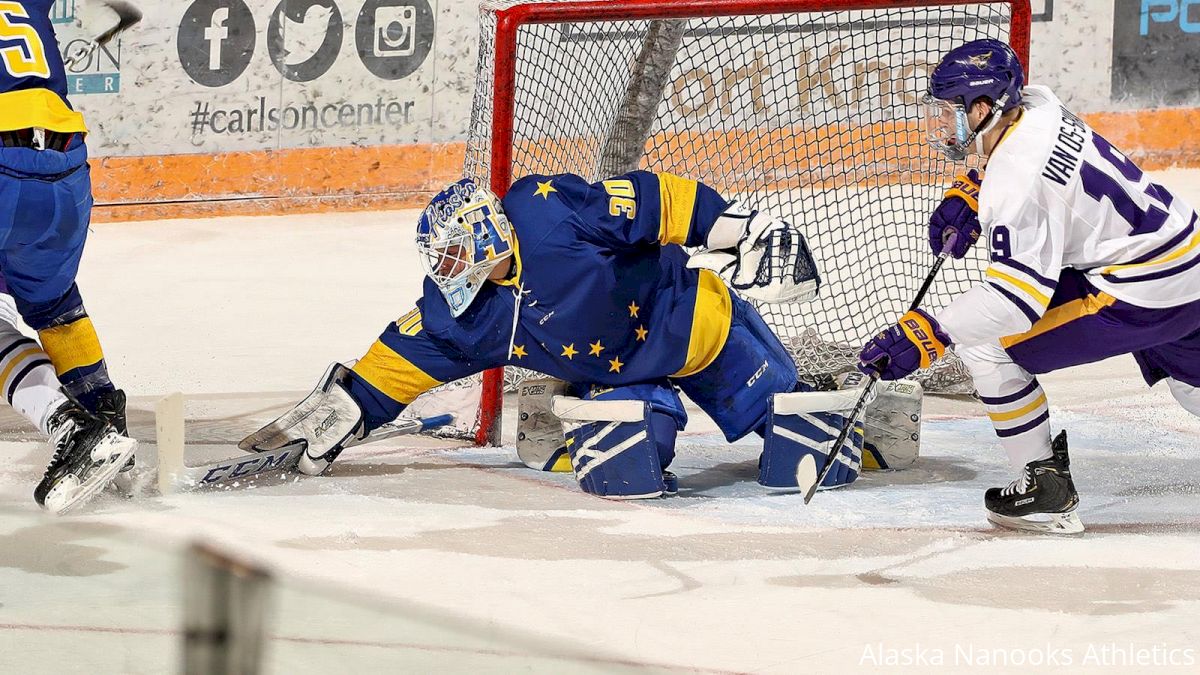Alaska Nanooks Develop Recruiting Pipeline In Latvia To Add Depth
Alaska Nanooks Develop Recruiting Pipeline In Latvia To Add Depth
The Nanooks have developed a recruiting pipeline from Fairbanks, Alaska, all the way to Riga, Latvia — over 4,000 mile, to be exact.

The distance from Riga, Latvia, to Fairbanks, Alaska, is 4,000 miles. But for Nanooks coach Erik Largen, that distance represents a shortcut to WCHA respectability.
“We’ve looked elsewhere to find recruits,” Largen said. “Gone to different markets.”
That’s a major understatement from the second-year coach, who, thanks in large part to assistant coach Karlis Zirnis, has brought in four new recruits from Latvia, increasing the Nanooks’ total to five. Joining returning sophomore netminder Gustavs Grigals will be defensemen Robert Kalkis, Markuss Komuls, and Kristaps Jakobsons, along with centerman Eriks Zohovs. It’s difficult to find a scouting report on the incoming freshmen, but the former Latvian Soviet Socialist Republic has a long and storied hockey tradition, and it’s beginning to make its mark on NCAA hockey.
From 2012-16, Latvian Teodors Blugers — known in North America as “Teddy Blueger — racked up over 100 points for Minnesota State and wore the “A” as an alternate captain for Mike Hastings’ Mavericks. Janis Jaks is a fourth-year senior for American International College, and helped the Yellow Jackets shock No. 1 St. Cloud in last spring’s NCAA tournament. Jaks represented Latvia at the IIHF World Championships last spring, as did forward Rihards Marenis, who played Division III hockey for Aurora from 2014-18. Marenis has moved on to the KHL, the second richest league in the world. Nanooks assistant coach Zirnis, who doubles as Latvia’s national junior coach, is using his influence to bring over skaters with national team experience.
Latvian U-20 coach Karlis Zirnas doubles as @NanooksHockey assistant coach. Has brought five Latvian nationals to Fairbanks help Nanooks this season pic.twitter.com/nx7kQt9pPD
— Tim Rappleye (@teeraps) September 22, 2019
“I’m a Latvian, and I go back quite a bit,” Zirnis said. “Me using those connections brought some kids over and they have a good opportunity to get educated and still play high-level hockey.”
Zirnis speaks from experience. Back in the early 2000s, he helped Alabama-Huntsville usher in Division I hockey to the American South. Unlike the Latvian quintet currently up in Fairbanks, Zirnis was a solo pioneer, playing in a foreign land with unfamiliar language and culture. Even though most of the current Latvian Nanooks have some junior hockey experience in North America, there is comfort having countrymen — and coach Zirnis — to share the ride through college hockey. This is especially helpful when it comes to language issues.
“It’s English-only in the locker room,” said Zirnis. “So if they don’t quite understand what’s going on, they can ask me some of the hockey terms.”
Zirnis brings Latvian candy into the locker room to give the boys a taste of home, and he’s considering sharing a traditional Latvian feast of schnitzel and potatoes with his charges during their major holidays.
Nanooks head coach Largen, looking to improve on last year’s seventh-place WCHA playoff spot, is happy with the depth gained from the far side of the Baltic Sea.
“We have a good incoming group of Latvian players,” Largen said. “Once you get one or two, suddenly there’s a pipeline.”
Largen likened his program’s Latvian connection to Minnesota State’s German contingent of Marc Michaelis, Parker Tuomie, and Julian Napravnik, a Deutsch troika that should combine for over 100 points of Maverick offense this season. The Latvians will not have anywhere near that kind of production up in the Last Frontier — they are essentially depth players. Freshman Kalkis appears to be the best of the bunch on paper, having represented Latvia on the men’s national team and, according to EliteProspects.com, suited up for one game in the KHL.
With a European-laden roster that includes three Swedes, a Finn, and a Dane in addition to the five Latvians, the Nanooks should benefit from a home-ice advantage. Games in Fairbanks are played at the Carlson Center, which has a 100-foot wide playing surface, typical of European rinks, which is 15 feet wider than the standard North American sheet. This should make the lads from overseas feel right at home.
“The transition will be easier,” said Zirnis, adding that their “European flair” will be a nice addition to the North American style.
The wide ice means that defensemen Kalkis, Komuls, and Jakobsons should be wise enough to avoid getting sucked into the cavernous corners of their defensive zone, and centerman Zohovs will use his technical skills to exploit the additional space, dropping down to help his wingmen create two-on-ones coming out of those extra-wide corners.
European players have earned their reputation for superior stick skills, having been raised with a much higher practice-to-game ratio than their North American counterparts. This creates the “flair” that Zirnis mentioned, known as “technical skill” in Eastern Europe. For a program fighting for survival, an influx of Europeans to artistically navigate the far reaches of the Carlson Center ice can only help the Nanooks in their struggle to make the WCHA playoffs.